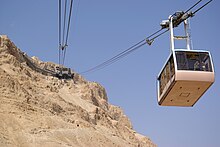
An aerial tramway, aerial tram, sky tram, aerial cablecar, aerial cableway, telepherique, or seilbahn is a type of aerial lift which uses one or two stationary ropes for support while a third moving rope provides propulsion. With this form of lift, the grip of an aerial tramway cabin is fixed onto the propulsion rope and cannot be decoupled from it during operations. In comparison to gondola lifts, aerial tramways generally provide lower line capacities and longer wait times.

A gondola lift is a means of cable transport and type of aerial lift which is supported and propelled by cables from above. It consists of a loop of steel wire rope that is strung between two stations, sometimes over intermediate supporting towers. The cable is driven by a bullwheel in a terminal, which is typically connected to an engine or electric motor. It is often considered a continuous system since it features a haul rope which continuously moves and circulates around two terminal stations. In contrast, an aerial tramway operates solely with fixed grips and simply shuttles back and forth between two end terminals.
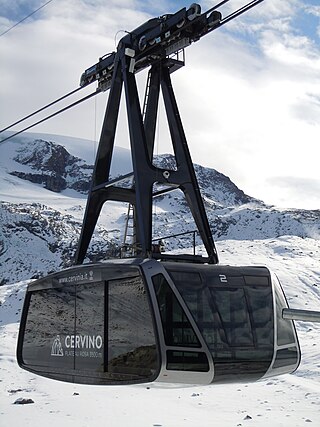
An aerial lift, also known as a cable car or ropeway, is a means of cable transport in which cabins, cars, gondolas, or open chairs are hauled above the ground by means of one or more cables. Aerial lift systems are frequently employed in a mountainous territory where roads are relatively difficult to build and use, and have seen extensive use in mining. Aerial lift systems are relatively easy to move and have been used to cross rivers and ravines. In more recent times, the cost-effectiveness and flexibility of aerial lifts have seen an increase of gondola lift being integrated into urban public transport systems.

Scenic World is a family-owned tourist attraction located in Katoomba in the Blue Mountains, New South Wales, Australia, about 100 kilometres west of Sydney. Scenic World is home to four attractions, the Scenic Railway, the Scenic Skyway, the Scenic Cableway and Scenic Walkway, a 2.4-km elevated boardwalk through ancient rainforest.

The Singapore Cable Car is a gondola lift in Singapore, providing an aerial link from Mount Faber on Singapore Island to the resort island of Sentosa across the Keppel Harbour.

The Glacial Aerial Tramway Kaprun III is the third section of the aerial tramway on the Kitzsteinhorn mountain at Kaprun, Austria. It was placed in service on 26 November 1966. It is currently branded Gipfelbahn.

Norsjö aerial tramway is a 13.2 kilometre long aerial tramway between Örträsk and Mensträsk in the Norsjö Municipality in Sweden.

The Cologne Cable Car is a gondola lift that runs across the river Rhine in Cologne, Germany. It connects the two banks of the Rhine at the height of Cologne's Zoo Bridge (Zoobrücke).

The Herzogstand Cable Car was built in 1994 as replacement for a 4,500-foot (1,400 m) chair lift through the Bavarian alps. Its two cabins carry passengers from the village of Walchensee to the Fahrenberg mountain on the upper slopes of the Herzogstand mountain. The cableway uses a 43 mm (1.7 in) carrying cable and a 21 mm (0.83 in) hauling cable. The cable car is driven by a 185 kilowatt engine. The cable way has two supports, which are 28 metres (92 ft) and 24 metres (79 ft) high. The journey time each way is four minutes and the cars reach a top speed of 8 metres per second (18 mph).

The Schauinslandbahn is a gondola lift in the Black Forest area of Baden-Württemberg, Germany. It links a lower station in the municipality of Horben, near the city of Freiburg im Breisgau, with an upper station near the summit of the Schauinsland mountain. The line is operated by VAG Freiburg, the city transport operator for Freiburg. The same company operates that city's tram and bus network, including bus route 21 that links the lower station of the Schauinslandbahn to the terminus of tram route 2 at Günterstal.

The tricable gondola lift, also known as the 3S gondola lift, is a cable car system that was developed by the Swiss company Von Roll transport systems in Thun to unite the benefits of a gondola lift with those of a reversible cable car system. '3S' is an abbreviation of the German word dreiseil, meaning 'tricable'.

The Wengen–Männlichen aerial cableway is a cable car linking Wengen with the Männlichen in Switzerland. It is owned and operated by the Luftseilbahn Wengen–Männlichen AG.
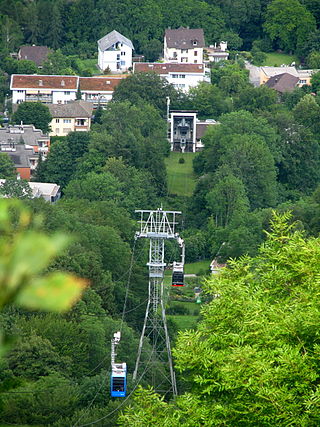
The Adliswil-Felsenegg cable car is a cable car in the canton of Zürich in Switzerland. The lower station is located in Adliswil in the Sihl Valley, whilst the upper station is located on the Felsenegg hill on the Albis ridge near the Felsenegg-Girstel TV-tower. The upper station at Felsenegg forms one end of a panoramic walk to the Uetliberg mountain, whilst the lower station is some 400 metres (1,300 ft) from Adliswil railway station.

The Port Vell Aerial Tramway is an aerial tramway in Barcelona, Catalonia, Spain. It crosses Port Vell, Barcelona's old harbour, connecting the Montjuïc hill with the seaside suburb of Barceloneta.
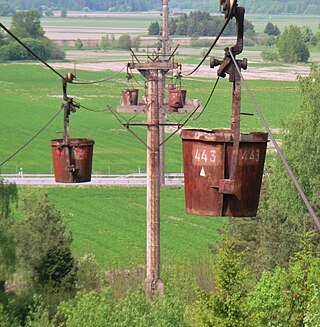
The Forsby-Köping limestone cableway, commonly referred to in Swedish as Kalklinbanan, was a 42 km aerial tramway running from Forsby in Vingåker municipality to industrial town Köping in central Sweden. Its final destination is the factory at the port of Köping, where cement was manufactured until 1978, and later various limestone derivatives. The cableway was Europe's longest at the time of construction. It was later superseded by a handful of longer cableways, notably the Norsjö aerial tramway, all of which were demolished during the 1960s–1980s. It was taken out of service in 1997 but kept in working order. By that time all longer industrial cableways had been demolished making it at present the world's longest cableway in working order.
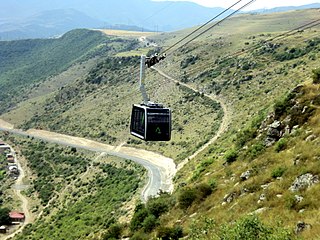
Wings of Tatev is a 5.7 km (3.5 mi) cableway between Halidzor and the Tatev monastery in Armenia. It is the longest reversible aerial tramway built in only one section, and holds the record for Longest non-stop double track cable car. Construction was finished on 16 October 2010.
A top station or upper station is usually the highest station of an aerial lift, a funicular, a T-bar lift or a rack railway. The lowest station is the valley station. Passengers or skiers usually alight at the top station.

Arosa Lenzerheide is a ski area located in Arosa, Lenzerheide, Valbella, Parpan and Churwalden, Graubünden/Switzerland. It originated 2013/14 by connecting the existing ski areas of Arosa and Lenzerheide. With a total of 225 kilometers of ski slopes and 43 cable cars it is the largest contiguous ski area in Graubünden.

The Wetterhorn Elevator was an aerial tramway in the valley of Grindelwald. It connected the base of the Upper Grindelwald Glacier to a higher location in the Wetterhorn massif. The tramway was inaugurated in 1908, making it the first of its kind in Switzerland. It closed only a few years later in 1915.
